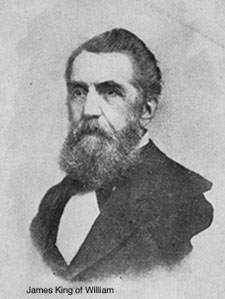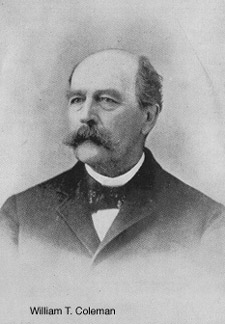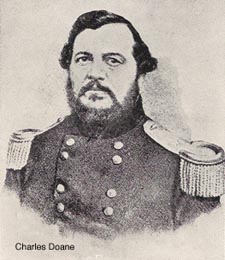 THE VIGILANTES
THE VIGILANTESFifty years ago today, when the first issue of the News Letter made its appearance, San Francisco was in control of the famous Vigilance Committee. This determined band of citizens held the city under as firm a rule as did the military a few weeks ago, when totally different causes demanded a stronger arm for the maintenance of right and order than the established civil Government afforded.
The Vigilance Committee owed its birth not to any extraordinary sudden event, but to the intolerable conditions which were the outgrowth of municipal corruption. It was the manifestation of the revolt of the decent element of the community against an organized gang of political plunderers, who held control of the city Government for their own aggrandizement and the oppression of the honest, respectable citizens.
There are few, if any, chapters in the history of the United States as interesting as that which records the doings of the Vigilance Committee during the rule of which, in 1856, the San Francisco News Letter was born.
For several years, the worst element in the city’s population had held control of the political machine, running the elections to suit itself, stuffing ballot boxes, intimidating those who could not be bribed, placing its own representatives in office, electing its own judges and generally enjoying a carnival of graft, loot and defiance of all the laws of civic decency. So strong and well organized was the machine that the respectable element of the town was seemingly helpless, at least at the ballot boxes.
The crisis came on May 14, 1856. On that day, James King, of William, editor of the Bulletin, who had unflinchingly, persistently and relentlessly assailed and exposed the misdeeds of the ring, was murdered in cold blood, at 5 p.m., by James Casey, a low politician, ballot-box stuffer and all-around bad character.
Trusting to immunity from punishment, on account of having the sympathy of police, district attorney, courts and other civil authorities, Casey surrendered himself, and was placed in jail, partly as a matter of form and partly to protect him from vengeance at the hands of King’s friends.
 The news of the murder spread abroad quickly. The respectable citizens, in desperation, determined to end the reign of outrage at any cost. About 7 p.m. a delegation of citizens went to William T. Coleman, and asked him to form a Vigilance Committee. Coleman, who had belonged to a Vigilance Committee, formed to correct abuses in 1851, was at first reluctant to take violent measures, but he was soon convinced that there was no alternative, if the existing conditions were not to be meekly endured.
The news of the murder spread abroad quickly. The respectable citizens, in desperation, determined to end the reign of outrage at any cost. About 7 p.m. a delegation of citizens went to William T. Coleman, and asked him to form a Vigilance Committee. Coleman, who had belonged to a Vigilance Committee, formed to correct abuses in 1851, was at first reluctant to take violent measures, but he was soon convinced that there was no alternative, if the existing conditions were not to be meekly endured.
Trusting to immunity from punishment, on account of having the sympathy of police, district attorney, courts and other civil authorities, Casey surrendered himself, and was placed in jail, partly as a matter of form and partly to protect him from vengeance at the hands of King’s friends.
 The news of the murder spread abroad quickly. The respectable citizens, in desperation, determined to end the reign of outrage at any cost. About 7 p.m. a delegation of citizens went to William T. Coleman, and asked him to form a Vigilance Committee. Coleman, who had belonged to a Vigilance Committee, formed to correct abuses in 1851, was at first reluctant to take violent measures, but he was soon convinced that there was no alternative, if the existing conditions were not to be meekly endured.
The news of the murder spread abroad quickly. The respectable citizens, in desperation, determined to end the reign of outrage at any cost. About 7 p.m. a delegation of citizens went to William T. Coleman, and asked him to form a Vigilance Committee. Coleman, who had belonged to a Vigilance Committee, formed to correct abuses in 1851, was at first reluctant to take violent measures, but he was soon convinced that there was no alternative, if the existing conditions were not to be meekly endured.
Accordingly a call was issued, signed “Committee of Thirteen,” the title under which the Vigilance Committee of 1851 was disbanded. The response was prompt and gratifying. Organization proceeded rapidly, military methods being followed, Doane, an experienced soldier, being placed in charge of the purely military details. Fort Gunnybags was erected on Sacramento Street, near Sansome, and cannon mounted behind its walls.
Dismayed b the suddenness and the completeness of the Vigilantes’ preparation, the corrupt city officials bestirred themselves to resist further operations. They gathered together the police and as many of their hoodlum constituents as they could muster, and began arming and drilling.
But their efforts to assert themselves were faint-hearted in the face of the determined attitude of the Vigilantes. The Governor, J. Neely Johnson, was appealed to, but he took no decided action one way or the other. General Wool and Captain (afterwards Admiral) Farragut, commanding the Federal forces, were asked to intervene, but they did not feel called upon to do so.
 The Sunday following the murder, the Vigilance Committee, well armed and thoroughly organized, proceeded to the jail, where its members overpowered the frightened guards, entered and took out Casey and another notorious character named Cora. The two captives were taken to the headquarters of the Vigilantes, where they were given a full, fair trial and found guilty.
The Sunday following the murder, the Vigilance Committee, well armed and thoroughly organized, proceeded to the jail, where its members overpowered the frightened guards, entered and took out Casey and another notorious character named Cora. The two captives were taken to the headquarters of the Vigilantes, where they were given a full, fair trial and found guilty.
Dismayed b the suddenness and the completeness of the Vigilantes’ preparation, the corrupt city officials bestirred themselves to resist further operations. They gathered together the police and as many of their hoodlum constituents as they could muster, and began arming and drilling.
But their efforts to assert themselves were faint-hearted in the face of the determined attitude of the Vigilantes. The Governor, J. Neely Johnson, was appealed to, but he took no decided action one way or the other. General Wool and Captain (afterwards Admiral) Farragut, commanding the Federal forces, were asked to intervene, but they did not feel called upon to do so.
 The Sunday following the murder, the Vigilance Committee, well armed and thoroughly organized, proceeded to the jail, where its members overpowered the frightened guards, entered and took out Casey and another notorious character named Cora. The two captives were taken to the headquarters of the Vigilantes, where they were given a full, fair trial and found guilty.
The Sunday following the murder, the Vigilance Committee, well armed and thoroughly organized, proceeded to the jail, where its members overpowered the frightened guards, entered and took out Casey and another notorious character named Cora. The two captives were taken to the headquarters of the Vigilantes, where they were given a full, fair trial and found guilty.
They were then carried forth and publicly executed, at the very hour when the body of James King, of William, was being escorted to the grave.
The corrupt Government, its hoodlum supporters, and the bad element of the city, were now thoroughly cowed, but the Vigilance Committee did not stop with the execution of Casey and Cora. It set itself diligently to work to purify the city Government and the city itself. Bad characters were exiled wholesale, the reins of Government were assumed by the Vigilantes, and a general cleaning out took place.
After three months of control, having taught a never-to-be-forgotten lesson to the corrupt and the criminal, and having seen a good municipal Government in charge, the Vigilance Committee disbanded, and thus ended one of the most remarkable instances on record of a revolt of decent citizens against a corrupt city Government.
The grafters exiled from the city by the Vigilantes subsequently sued Coleman for sums amounting to a total of $1,500,000, but the suits were all defeated, Coleman and the Vigilance Committee being upheld by every court East and West which considered the cases.
San Francisco News Letter and California Advertiser
July 21, 1906
The grafters exiled from the city by the Vigilantes subsequently sued Coleman for sums amounting to a total of $1,500,000, but the suits were all defeated, Coleman and the Vigilance Committee being upheld by every court East and West which considered the cases.
San Francisco News Letter and California Advertiser
July 21, 1906

I heard that when this article was first written in 1906, it didn't receive a lot of news coverage due to the San Francisco earthquake that happened that year. Whether or not this is true I don't know. But I plan on making a movie about it in the future called, "Once Upon A Time In San Francisco". It will take place in 1906 and I will play the role of Moses Clay, a reporter who is sent to San Francisco on assignment in order to cover a news story. He is an expert at what he does since only twenty years earlier, he covered the capture of Geronimo. But another figure, Kid Blaine, has arrived in San Francisco looking to kill Clay. His reason for doing so is that Clay wrote an article about him being in an outlaw gang in Oklahoma that was responsible for the murder of a married couple. What the town of San Francisco does not know is that Moses Clay can use a gun and he uses this to his advantage. Later on, when Kid Blaine realizes he can't take on Moses Clay alone, he hires the Mafia to help him. He recruits the services of Don Vicente Petri who tells him that Moses Clay can easily be taken out at night. When one of Petri's men, Carlo, is killed by Clay in a bar, Don Vicente ups the ante by hiring his son-in-law Fabiano to kill Clay. But this later becomes a failure when Fabiano sides with Clay. During his battle with Kid Blaine and the Mafia, Clay is notified of an earthquake coming to San Francisco. Once it arrives, his plans are put on hold. He later finds out that the earthquake has killed Fabiano and that Don Vicente has increased the bounty on Clay's head. In the end, Clay has a final showdown with Don Vicente and Kid Blaine and in the end kills them both. He the buys a ranch out in Arizona and lives happily ever after. At least that's how my movie will end. Wish me luck.
ReplyDelete